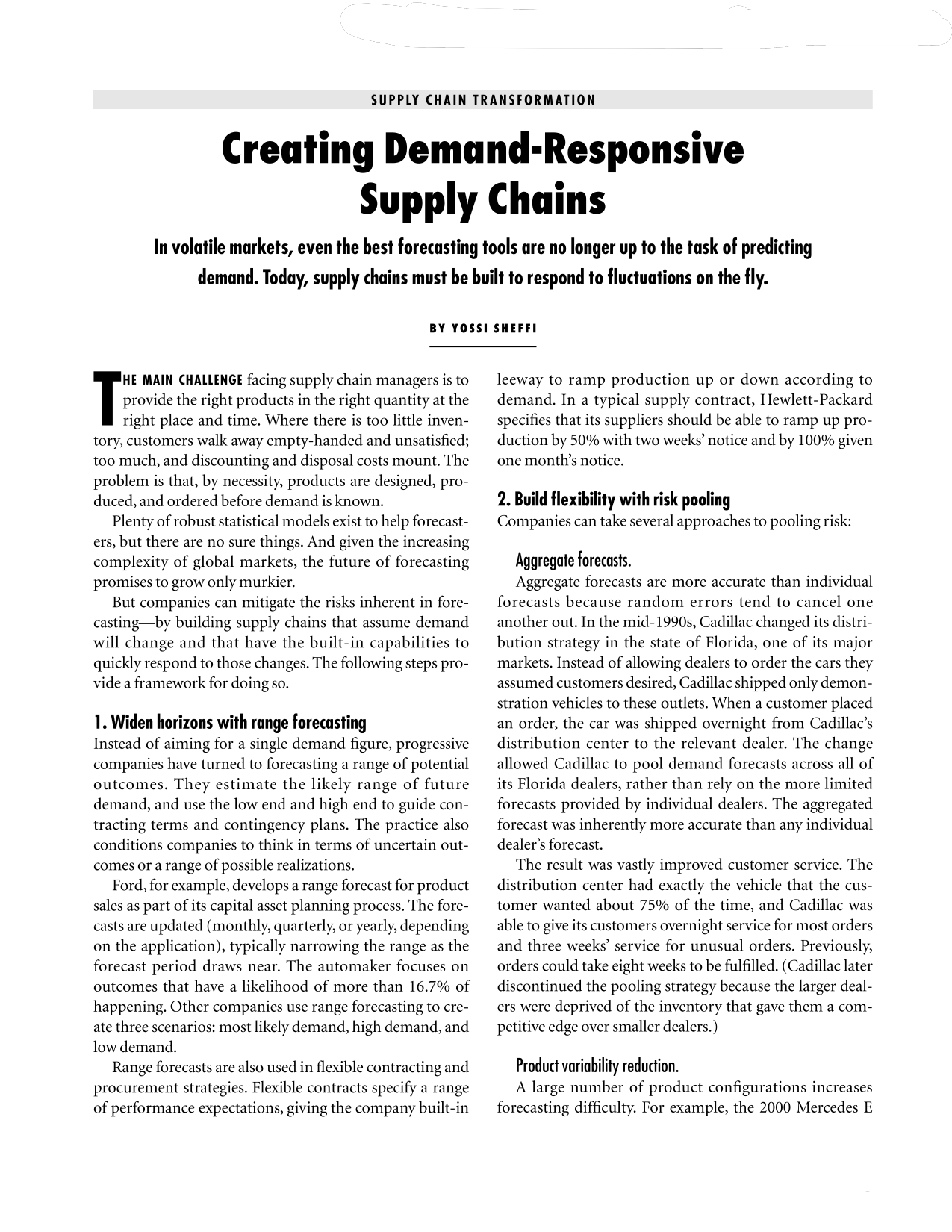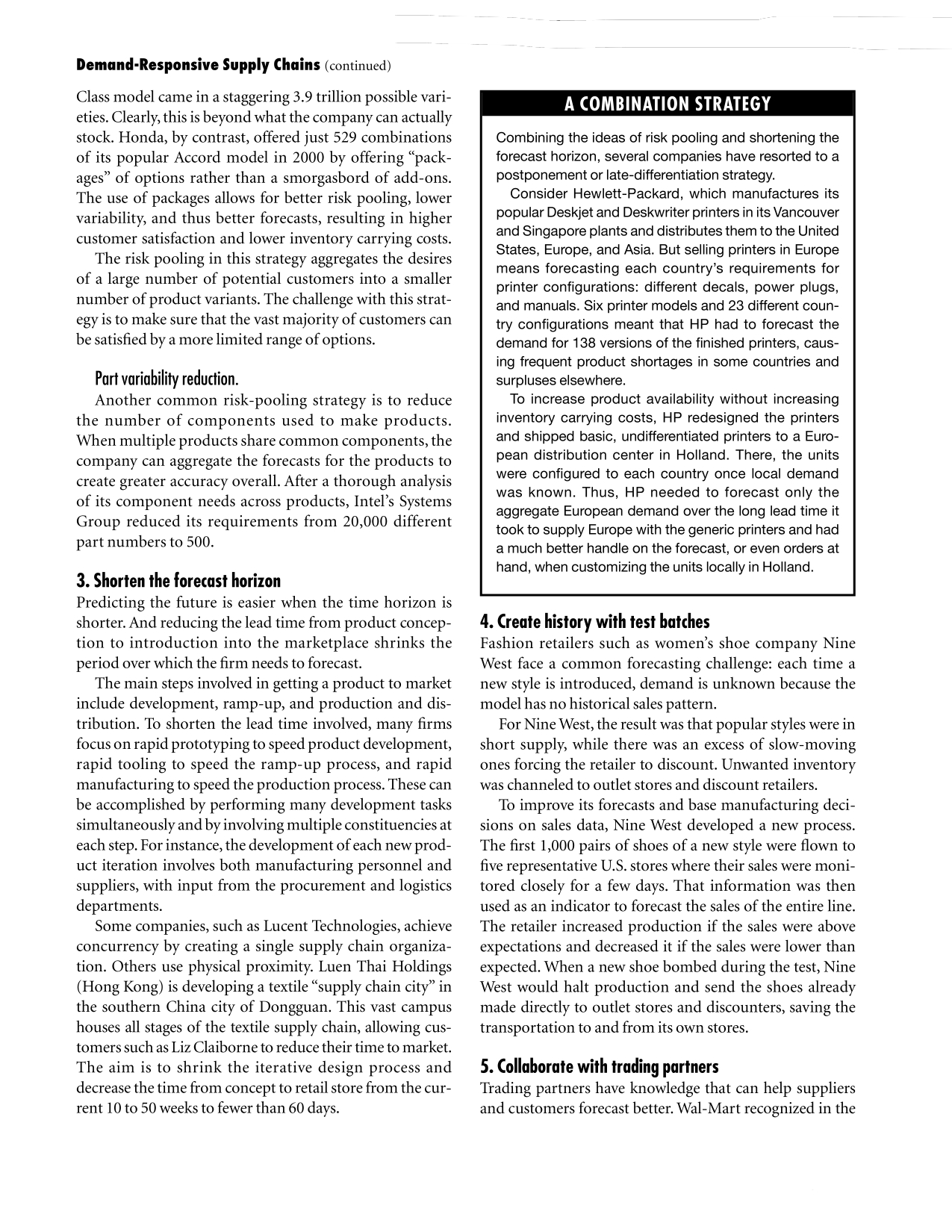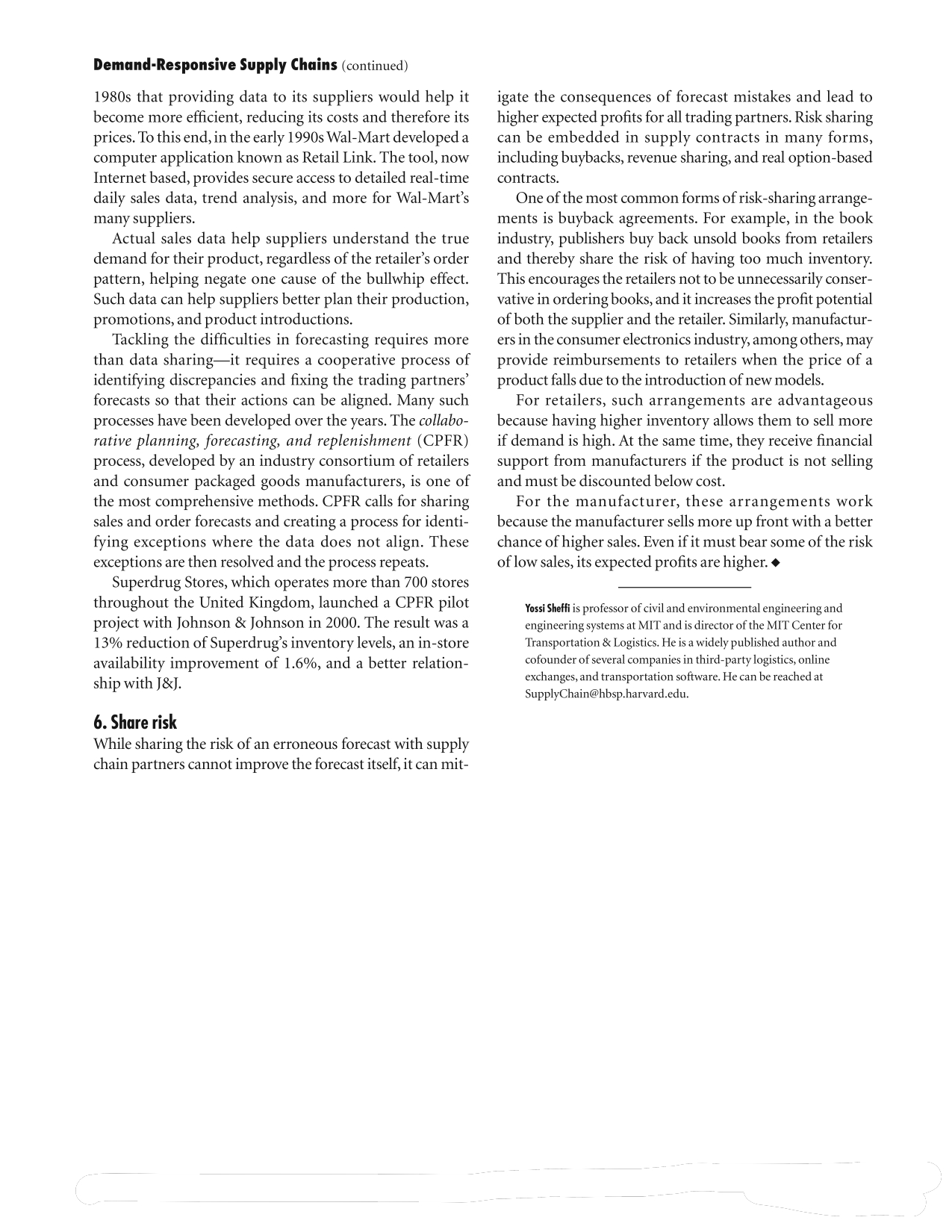SUPPLY (I'IMII iliANSFORMM'IOI'l Creating Demand-Responsive Supply Chains In volatile markets, even the best forecasting tools are no longer up to the task of predicting demand. Today, supply chains must he built to respond to fluctuations on the fly. IY YOSSI Sllllll provide the right products in the right quantity at the right place and time. Where there is too little inven tory, customers walk away emptyehanded and unsatised; too much, and discounting and disposal costs mount. The problem is that, by necessity, products are designed, pro- duced, and ordered before demand is known. Plenty of robust statistical models exist to help forecast- ers, but there are no sure things. And given the increasing complexity of global markets, the future of forecasting promises to grow only murkier. But companies can mitigate the risks inherent in fore- castingby building supply chains that assume demand will change and that have the built-in capabilities to quickly respond to those changes. The following steps pro vide a framework for doing so. THE MAIN (HAILENGE facing supply chain managers is to l. Widen horirons with range forecasting Instead of aiming for a single demand gure, progressive companies have turned to forecasting a range of potential outcomes. They estimate the likely range of future demand, and use the low end and high end to guide con- tracting terms and contingency plans. The practice also conditions companies to think in terms of uncertain out- comes or a range of possible realizations. Ford, for example, develops a range forecast for product sales as part of its capital asset planning process. The fore casts are updated (monthly, quarterly, or yearly, depending on the application), typically narrowing the range as the forecast period draws near. The automaker focuses on outcomes that have a likelihood of more than 16.7% of happening. Other companies use range forecasting to cre- ate three scenarios: most likely demand. high demand, and low demand. Range forecasts are also used in exible contracting and procurement strategies. Flexible contracts specify a range of performance expectations, giving the company built-in leeway to ramp production up or down according to demand. In a typical supply contract, Hewlett-Packard species that its suppliers should be able to ramp up pro- duction by 50% with two weeks' notice and by 100% given one month's notice. 2. Build flexibility with risk pooling Companies can take several approaches to pooling risk: Aggregate forecasts. Aggregate forecasts are more accurate than individual forecasts because random errors tend to cancel one another out. In the mid-19905, Cadillac changed its distri- bution strategy in the state of Florida, one of its major markets. Instead of allowing dealers to order the cars they assumed customers desired. Cadillac shipped only demon- stration vehicles to these outlets. When a customer placed an order, the car was shipped overnight from Cadillac's distribution center to the relevant dealer. The change allowed Cadillac to pool demand forecasts across all of its Florida dealers, rather than rely on the more limited forecasts provided by individual dealers. The aggregated forecast was inherently more accurate than any individual dealer's forecast. The result was vastly improved customer service. The distribution center had exactly the vehicle that the cus- tomer wanted about 75% of the time, and Cadillac was able to give its customers overnight service for most orders and three weeks' service for unusual orders. Previously, orders could take eight weeks to be fullled. (Cadillac later discontinued the pooling strategy because the larger deal- ers were deprived of the inventory that gave them a come petitive edge over smaller dealers.) Product variability reduction. A large number of product congurations increases forecasting difficulty. For example, the 2000 Mercedes E Demand-Responsive Supply Chains (continued) Class model came in a staggering 3.9 trillion possible vari- eties. Clearly, this is beyond what the company can actually stock. Honda, by contrast, offered just 529 combinations of its popular Accord model in 2000 by offering \"pack ages\" of options rather than a smorgasbord of add-ons. The use of packages allows for better risk pooling, lower variability, and thus better forecasts, resulting in higher customer satisfaction and lower inventory carrying costs. The risk pooling in this strategy aggregates the desires of a large number of potential customers into a smaller number of product variants. The challenge with this strat- egy is to make sure that the vast majority of customers can be satised by a more limited range of options. Part variability reduction. Another common riskepooling strategy is to reduce the number of components used to make products. When multiple products share common components, the company can aggregate the forecasts for the products to create greater accuracy overall. After a thorough analysis of its component needs across products, Intel's Systems Group reduced its requirements from 20,000 different part numbers to 500. 3. Shorten the forecast horizon Predicting the future is easier when the time horizon is shorter. And reducing the lead time from product concep tion to introduction into the marketplace shrinks the period over which the rm needs to forecast. The main steps involved in getting a product to market include development, ramp-up, and production and dis- tribution. To shorten the lead time involved, many rms focus on rapid prototyping to speed product development, rapid tooling to speed the ramp-up process, and rapid manufacturing to speed the production process. These can be accomplished by performing many development tasks simultaneously and by involving multiple constituencies at each step. For instance, the development of each new prod uct iteration involves both manufacturing personnel and suppliers, with input from the procurement and logistics departments. Some companies, such as Lucent Technologies, achieve concurrency by creating a single supply chain organiza- tion. Others use physical proximity Luen Thai Holdings [Hong Kong) is developing a textile \"supply chain city\" in the southern China city of Dongguan. This vast campus houses all stages of the textile supply chain, allowing cus- tomers such as Liz Claiborne to reduce their time to market. The aim is to shrink the iterative design process and decrease the time from concept to retail store from the cur rent 10 to 50 weeks to fewer than 60 days. A COMBINATION STRATEGY Combining the ideas of risk pooling and shortening the forecast horizon, several companies have resorted to a postponement or late-differentiation strategy. Consider Hewlett-Packard. which manufactures its popular Deskjet and Deskwriter printers in its Vancouver and Singapore plants and distributes them to the United States, Europe. and Asia. But selling printers in Europe means forecasting each country's requirements for printer congurations: different decals. power plugs. and manuals. Six printer models and 23 different coun- try congurations meant that HP had to forecast the demand for 138 versions of the finished printers, caus- ing frequent product shortages in some countries and surpluses elsewhere. To increase product availability without increasing inventory carrying costs. HP redesigned the printers and shipped basic, undifferentiated printers to a Euro- pean distribution center in Holland. There. the units were congured to each country once local demand was known. Thus. HP needed to forecast only the aggregate European demand over the long lead time it took to supply Europe with the generic printers and had a much better handle on the forecast. or even orders at hand. when customizing the units locally in Holland. 4. Create history with test hatches Fashion retailers such as women's shoe company Nine West face a common forecasting challenge: each time a new style is introduced, demand is unknown because the model has no historical sales pattern. For Nine West, the result was that popular styles were in short supply, while there was an excess of slowmoving ones forcing the retailer to discount. Unwanted inventory was channeled to outlet stores and discount retailers. To improve its forecasts and base manufacturing deci- sions on sales data, Nine West developed a new process. The rst 1,000 pairs of shoes of a new style were own to ve representative U.S. stores where their sales were moni- tored closely for a few days. That information was then used as an indicator to forecast the sales of the entire line. The retailer increased production if the sales were above expectations and decreased it if the sales were lower than expected. When a new shoe bombed during the test, Nine West would halt production and send the shoes already made directly to outlet stores and discounters, saving the transportation to and from its own stores. 5. Collaborate with trading partners Trading partners have knowledge that can help suppliers and customers forecast better. Wal-Mart recognized in the Demand-Responsive Supply Clmins (continued) 19805 that providing data to its suppliers would help it become more efcient, reducing its costs and therefore its prices. To this end, in the early 19905 WalMart developed a computer application known as Retail Link. The tool, now Internet based, provides secure access to detailed real-time daily sales data, trend analysis, and more for Wal-Mart's many suppliers. Actual sales data help suppliers understand the true demand for their product, regardless of the retailer's order pattern, helping negate one cause of the bullwhip effect. Such data can help suppliers better plan their production, promotions, and product introductions. Tackling the difculties in forecasting requires more than data sharingit requires a cooperative process of identifying discrepancies and xing the trading partners' forecasts so that their actions can be aligned. Many such processes have been developed over the years. The collabo- rative planning, forecasting, and replenishment (CPFR) process, developed by an industry consortium of retailers and consumer packaged goods manufacturers, is one of the most comprehensive methods. CPFR calls for sharing sales and order forecasts and creating a process for identi- fying exceptions where the data does not align. These exceptions are then resolved and the process repeats. Superdrug Stores, which operates more than 700 stores throughout the United Kingdom, launched a CPFR pilot project with Johnson 8: Johnson in 2000. The result was a 13% reduction of Superdrug's inventory levels, an inestore availability improvement of 1.6%, and a better relation- ship with 18:]. 6. Share risk While sharing the risk of an erroneous forecast with supply chain partners cannot improve the forecast itself, it can mit- igate the consequences of forecast mistakes and lead to higher expected prots for all trading partners. Risk sharing can be embedded in supply contracts in many forms, including buybacks, revenue sharing, and real optionbased contracts. One of the most common forms of risk-sharing arrange- ments is buyback agreements. For example, in the book industry, publishers buy back unsold books from retailers and thereby share the risk of having too much inventory. This encourages the retailers not to be unnecessarily co user- vative in ordering books, and it increases the prot potential of both the supplier and the retailer. Similarly, manufactur ers in the consumer electronics industry, among others, may provide reimbursements to retailers when the price of a product falls due to the introduction of new models. For retailers, such arrangements are advantageous because having higher inventory allows them to sell more if demand is high. At the same time, they receive nancial support from manufacturers if the product is not selling and must be discounted below cost. For the manufacturer, these arrangements work because the manufacturer sells more up front with a better chance of higher sales. Even if it must bear some of the risk of low sales, its expected prots are higher. 0 Ynssi Shelli is professor of civil and environmental engineering and engineering systems at MIT and is director of the MIT Center for Transportation 8( Logistics. He is a widely published author and cofounder of several companies in thirdparty logistics, online exch anges, and transportation software. He can be reach ed at Suppinhainhbspharvardcdu









